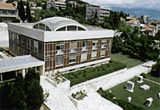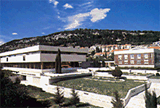
The Museum of Croatian Archaeological Monuments was founded on 24th August 1893 in Knin under the name First Museum of Croatian Monuments with the aim to store all mediaeval monuments of Croatian archaeological heritage.
Owing to the efforts of the Franciscan Lujo Marun, a great number of monuments was already collected by that time, which were stored in the monastery of St. Anthony in Knin. With the rising demand of the Museum, a new building was erected on the site of the monastery’s dilapidated eastern wing.

Due to the increased number of monuments, that exceeded the capacity of the building, the Museum moved into the neighbouring house Fontana in 1912, followed by another relocation in 1933 to a house on the Knin Fortress that was specially adapted for this purpose.
With the beginning of World War II and due to the military purpose of the Knin Fortress, the Museum’s director at that time, Stjepan Gunjača, secretly moved the Museum’s artefacts to Sinj where they remained until 1945. This decision soon proved justified. The building, from the where the monuments were moved, was destroyed in an air strike already in 1943.
In 1946, the construction of a new building was started for the needs of the Museum at the Knin Fortress. However, due to its isolated location, this project was shortly after dropped, so that the monuments were moved to the Meštrović-Gallery in Split.
In 1955, the Museum was moved to warehouses of the former cement plant at the west bank of the Split harbour, where a new museum building was envisaged. Here, the permanent exhibition was reopened for the public in 1958, but only until 1960, when the decision on building the museum at that location was dismissed.
Finally in 1968, it was decided to erect the Museum’s building on its present location in Split’s quarter Meje. The building was constructed according to the design of M. Kauzlarić and officially opened on 5 December 1976, while the permanent exhibition reopened on 25 July 1978.